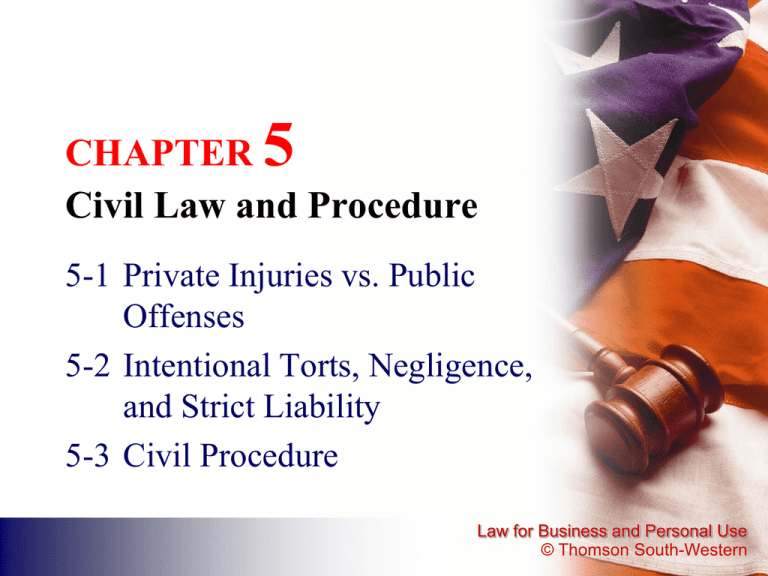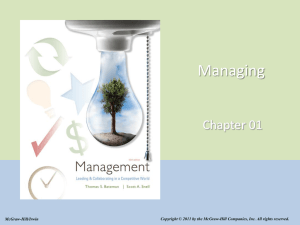Chapter 5 - Trimble County Schools
advertisement

5 CHAPTER Civil Law and Procedure 5-1 Private Injuries vs. Public Offenses 5-2 Intentional Torts, Negligence, and Strict Liability 5-3 Civil Procedure Law for Business and Personal Use © Thomson South-Western 5-1 Private Injuries vs. Public Offenses GOALS Distinguish a crime from a tort Identify the elements of torts Explain why one person may be responsible for another’s tort Chapter 5 Slide 2 Law for Business and Personal Use © Thomson South-Western FOCUS What is a tort? What is the difference between crimes and torts? Chapter 5 Slide 3 Law for Business and Personal Use © Thomson South-Western HOW DO CRIMES AND TORTS DIFFER? Offense against society Offense against individual damages Chapter 5 Slide 4 Law for Business and Personal Use © Thomson South-Western What is the difference between a crime and a tort? Chapter 5 Slide 5 Law for Business and Personal Use © Thomson South-Western ELEMENTS OF A TORT Duty Violation of the duty Injury Causation Chapter 5 Slide 6 Law for Business and Personal Use © Thomson South-Western Name the four elements of a tort. Chapter 5 Slide 7 Law for Business and Personal Use © Thomson South-Western RESPONSIBILITY FOR ANOTHER’S TORTS Vicarious liability Chapter 5 Slide 8 Law for Business and Personal Use © Thomson South-Western What parties might be held responsible for another person’s tort? Chapter 5 Slide 9 Law for Business and Personal Use © Thomson South-Western 5-2 Intentional Torts, Negligence, and Strict Liability GOALS Identify common intentional torts Recognize the elements of negligence Explain the basis for strict liability Chapter 5 Slide 10 Law for Business and Personal Use © Thomson South-Western FOCUS What things are unique about the intentional torts? Chapter 5 Slide 11 Law for Business and Personal Use © Thomson South-Western WHAT ARE THE MOST COMMON INTENTIONAL TORTS? Assault Battery False imprisonment Defamation Invasion of privacy Trespass to land Conversion Interference with contractual relations Fraud Chapter 5 Slide 12 Law for Business and Personal Use © Thomson South-Western Name at least six of the nine most common intentional torts. Chapter 5 Slide 13 Law for Business and Personal Use © Thomson South-Western WHAT CONSTITUTES NEGLIGENCE? Duty imposed by negligence Breach of duty Causation and injury Defenses to negligence Chapter 5 Slide 14 Law for Business and Personal Use © Thomson South-Western Name the four elements that must be proven for an act to be negligent. Chapter 5 Slide 15 Law for Business and Personal Use © Thomson South-Western WHY IS STRICT LIABILITY NECESSARY? Engaging in abnormally dangerous activities Owning dangerous animals Selling unreasonably dangerous goods Chapter 5 Slide 16 Law for Business and Personal Use © Thomson South-Western What is strict liability and why is it necessary? Chapter 5 Slide 17 Law for Business and Personal Use © Thomson South-Western 5-3 Civil Procedure GOALS State the legal remedies that are available to a tort victim Describe the procedure used to try a civil case Explain how civil damages are collected Chapter 5 Slide 18 Law for Business and Personal Use © Thomson South-Western FOCUS What remedies are available in a civil suit? Chapter 5 Slide 19 Law for Business and Personal Use © Thomson South-Western REMEDIES AVAILABLE IN A CIVIL SUIT Injunction Damages Chapter 5 Slide 20 Law for Business and Personal Use © Thomson South-Western Name the two remedies available in a civil suit. Chapter 5 Slide 21 Law for Business and Personal Use © Thomson South-Western WHAT PROCEDURE IS USED TO TRY A CIVIL CASE? Judge or jury Opening statements and testimony Closing arguments and instructions to the jury Jury deliberation and the verdict Chapter 5 Slide 22 Law for Business and Personal Use © Thomson South-Western List the steps in the procedure used to try a civil case. Chapter 5 Slide 23 Law for Business and Personal Use © Thomson South-Western HOW ARE CIVIL DAMAGES COLLECTED? Defendant is ordered to pay Writ of execution Chapter 5 Slide 24 Law for Business and Personal Use © Thomson South-Western How does a plaintiff collect damages if the defendant refuses to pay? Chapter 5 Slide 25 Law for Business and Personal Use © Thomson South-Western





